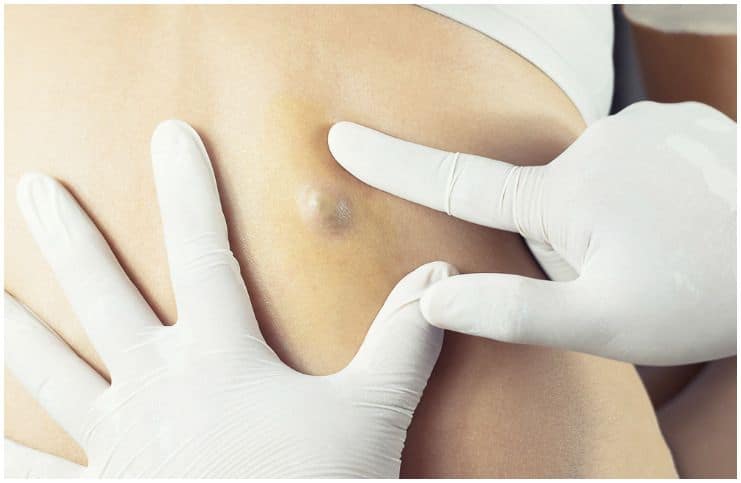A blister, also referred to as a vesicle by doctors, is a raised portion of skin that is filled with plasma, serum, pus, or blood, depending on where and how they are formed.
It can develop if there’s intense rubbing over shorter periods or if the skin is rubbed for a long period. In contrast to abscesses, which are collections of inflammatory fluid found deep in the tissues, blisters are found in the Malpighian layer (the most superficial layer) of the skin.
Sebaceous cysts are abnormalities in the human body that may contain semiliquid or liquid material. They can occur anywhere on the body, however, they are usually found on the neck, face, and torso.
They may be caused by swollen hair follicles or blocked glands in the skin. The main symptom of this type of cyst is a lump under the skin, which is not painful.
Here are 10 essential oils for blisters, sebaceous cysts, and abscesses:
#1 Peppermint
This herb has a long history of documented use, going back as far as Roman times when the Roman naturalist and natural philosopher – Pliny the Elder – described its use, including for indigestion, headaches, skin conditions, and muscle aches. In the present day, it is appreciated by the medical and scientific community, hence, we can find it in mints, mouthwash, and other products.
#2 Tea Tree
Tea tree essential oil, also referred to as melaleuca oil, is extracted from the leaves of the Melaleuca tea tree. Tea tree oil has long been employed for its antibacterial and antiseptic properties.
Also, it is effective for fighting a staph infection (caused by staphylococcus bacteria), including those that are resistant to antibiotics.
Plus, this essential oil is thought to be one of the most effective methods to treat acne, not just on the face, but on the arms, back, and chest as well.
#3 Lavender
The main constituents of the lavender essential oil include – linalool (a non-toxic terpene alcohol), linalyl acetate, camphor, and terpinen-4-ol.
This essential oil has natural anti-inflammatory and sedative properties which may help individuals with asthma (a lung disease that narrows and inflames the airways) fight inflammation.
Moreover, this oil has been utilized as an antimicrobial protectant against infections and skin problems, according to a study issued in the journal Evidence-Based Complementary and Alternative Medicine.
#4 Myrrh
This essential oil is extracted from myrrh, a resin that comes from a tree with the botanical name of – Commiphora myrrha, originated from the Middle East or Africa.
It has natural anti-septic characteristics and can reduce and prevent infections. Moreover, it supports skin health as well as it reduces stretch marks. You can use myrrh essential oil as follows:
- add it to lotions and creams to help relieve skin infections, like – ringworm, athlete’s foot, bedsores, abscesses, weeping eczema, carbuncles, boils, blisters, and acne.
- put it in a cold compress to help relieve wounds and sores.
- use it as a mouthwash to help eliminate oral infections.
#5 Eucalyptus
Many people use eucalyptus essential oil as a natural remedy for sinus blockage, stubborn cough, and bronchitis because it effectively loosens up mucus from the airways. Also, Eucalyptus oil is effective against insect bites and stings.
Its germicidal qualities provide strong antiseptic protection to burns, wounds, abrasions cuts, and ulcers. Moreover, this essential oil inhibits considerably both herpes simplex virus-1 and -2, according to a 2001 study.
#6 Chamomile
Chamomile essential oil is renowned for its remarkable calming benefits, plus, it has long served as an effective natural treatment for conditions, such as – muscle spasms, chronic inflammation, flatulence, upset stomach, migraine headaches, fungi, and parasites.
More importantly, recent research has concluded that this essential oil has little effect on normal and healthy cells, however, it has a notable effect in inhibiting human cancer cells.
In addition, it has astringent properties, which makes it ideal for skin-cleansing treatments. For this, you just need to use the chamomile essential oil to the affected skin area.
#7 Geranium
It is extracted by distilling the green parts of the plant, mainly the leaves. This essential oil is one of the most important and effective oils in aromatherapy.
Geranium oil is antiseptic and a hemostatic, and is commonly used for general fatigue, tiredness, and convalescence. In addition, it is effective as a natural skincare product since it may help battle problems, like – oily skin, acne, eczema, abscesses, and dermatitis.
#8 Clove
It is produced from the flower buds of the Eugenia caryophyllata, a tree that is native to the Spice Islands (or the Maluku Islands). However, in the present day, it is grown in many tropical areas worldwide.
You can use clove essential oil for curing nettle stings and insect bites. Furthermore, it is used to treat cuts, wounds, prickly heat, fungal infections, blisters, and athlete’s foot. Another substantial benefit of this essential oil is the cleansing properties it holds for oral care.
Tip – always dilute it before application.
#9 Melissa
Melissa essential oil is used in aromatherapy to treat many health problems, such as -anxiety, insomnia, migraines, diabetes, hypertension, skin problems, dementia, and herpes.
Additionally, it has potent antibacterial properties and, according to some studies, it is effective in inhibiting bacterial infections in the intestines, large intestine, kidneys, and urinary tract.
#10 Lemon
Lemon essential oil is a natural antiseptic and can be used on small scrapes, cuts, and other skin problems to accelerate the healing process.
When used internally, lemon oil may support the overall healthy functioning of the respiratory and digestive systems. When diffused, it eliminates toxins in the air, enhances energy levels and concentration, and reduces anxiety.
Images credit – Shutterstock
READ THIS NEXT: Essential Oils For Nerve Damage (Peripheral Neuropathy)
